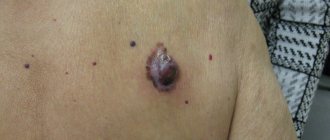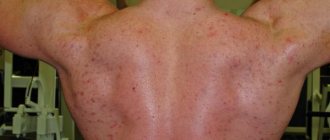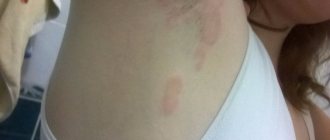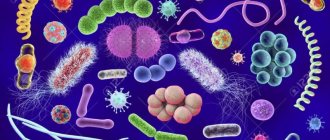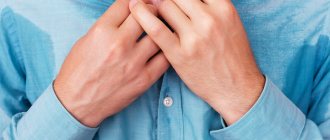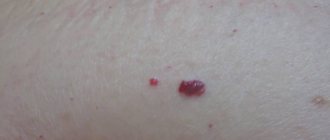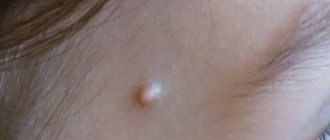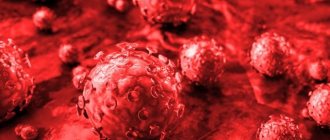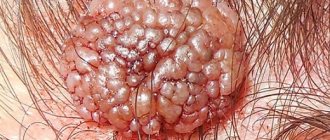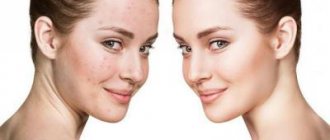Dermatovenerologist (1 KO, 1/35)
Kintaev
Azamat Samuratovich
7 years experience
Dermatovenerologist
Make an appointment
Ringworm (microsporia) is a disease manifested as a fungal infection of the skin, nail plates and hair follicles. The pathogen is a mold fungus of the genus Microsporum. Its colonies form in keratinized substrates. Microsporia remains a relatively common disease - dermatologists identify 60-75 cases for every hundred thousand Moscow residents. The pathology has a pronounced seasonality. The peak incidence occurs at the end of summer and beginning of autumn - the period of breeding of offspring in cats and other animals.
Varieties
Not everyone knows that this disease can be represented by three types.
- Surface.
- Infiltrative - suppurative.
- Chronic.
In addition to differences in the course of the disease and the presence of characteristic manifestations, the species also differ in the incubation period. So for the first it is no more than a week, often five days, for the second it is up to two months. Chronic - develops due to the lack of proper and timely treatment, sometimes it can go away, and then occurs again.
Causes
Ringworm on a child’s head can be caused by the following predisposing factors:
- lack of personal hygiene rules;
- contact with infected animals or people;
- infection by contact through the use of personal items of a sick child;
- weakened immune system;
- the presence of chronic pathologies, in particular their exacerbation;
- the presence of wounds on the surface of the skin, in particular burns, scratches, hangnails;
- state of constant stress;
- vitamin deficiency or a significant decrease in the level of vitamins in the body.
How to treat ringworm in humans
The principles of therapy depend on the type of microsporia and trichophytosis. Effective treatment involves the use of both local and systemic antifungal drugs. If only the superficial layers of the skin are affected, doctors advise limiting the use of ointments, liniments and creams.
In case of rapid progression of the disease, systemic antimycotics - tablets, suspensions, capsules - are included in the treatment regimen.
Drug therapy
At the initial stage of development of dermatophytosis, local treatment can be carried out with antifungal ointments, shampoos, gels and sprays. Effective medications against ringworm include:
- Ketoconazole is an ointment based on imidazoledioxolane derivatives, which quickly eliminates itching and flaking of the skin.
- Terbinafine is a fungicidal ointment that improves skin condition by healing foci of inflammation and accelerating regenerative processes in the epidermis.
- Clotrimazole is a fungicidal antifungal cream that not only eliminates the symptoms of dermatophytosis, but also prevents the development of secondary pyoderma.
Before getting rid of ringworm using pharmaceutical products, you should consult your doctor. Additionally, he may prescribe treatment of plaques with salicylic acid or sulfur-tar ointment.
In severe cases of dermatophytosis, systemic medications are used - Griseofulvin, Exifin, Oronazole. In addition to antifungal agents, therapy may include immunostimulants and drugs that improve blood microcirculation in the affected areas.
Additional treatments
Treatment of microsporia on the head should begin with hair removal in the affected areas. To speed up recovery, a dermatologist may prescribe physiotherapeutic procedures:
- UV irradiation;
- electrophoresis;
- microwave therapy;
- UHF therapy;
- photophoresis.
If nails are damaged, local treatment is carried out using antiseptics - iodine solution or Yoddicerin. It is necessary to limit contact with water to prevent further spread of infection.
Folk remedies and recipes
Treatment of trichophytosis in humans does not exclude the use of folk remedies that have antifungal properties. Among folk recipes, there are many options for treating ringworm on the skin. To destroy pathogens of dermatomycosis, raisins, honey with garlic, birch tar, apple cider vinegar, lemon, etc. can be used. The most effective remedies include:
- Garlic with lemon - a mixture of grated products is applied to the lesions and bandaged for 2 hours daily at least 2 times a day.
- Birch tar with butter - the products are mixed in equal proportions and applied to the skin 3 times a day.
- Raisins – softened seedless raisins are rubbed daily on pink spots and the skin around them 3-4 times a day.
Skin care
During the treatment, special attention is paid to hair and body care. It is recommended to wash your hair only with antifungal shampoos, which inhibit the proliferation of fungal flora. The procedure must be performed at least once every 2 days.
To prevent the disease, we do not recommend washing in public places, strengthening the immune system, vaccinating pets, and maintaining personal hygiene.
To treat affected areas, use fungicidal soap based on tar, turpentine or tea tree oil. To prevent the spread of infection, all underwear should be washed daily at 90°C.
Main symptoms
At the slightest suspicion of this disease, it is necessary to know the main signs of ringworm in children in order to diagnose the disease in a timely manner.
- Dull hair, weakened, brittle.
- Formation of bald areas up to 10 cm in diameter.
- Characteristically, there are oval and round spots with white and yellow scales.
- Over time, nodules appear, circles and ovals spread to the neck, face, body and limbs.
- Moderate itching may be present.
- The lesion has a red or pink rim, nodules and blisters are present.
- If the nails are affected, the plates separate, crumble, become gray, or very thin or thick.
Signs of chronic form
- Growth of lichen on the temples and back of the head.
- Lack of contours on spots.
- Acquiring a bluish tint to the affected areas.
Symptoms of infiltrative-suppurative form
- The presence of lichen on the scalp is bright red in color.
- The presence of large, lumpy plaques, up to 10 cm in diameter.
- Discharge of pus on the surface of the head from inflamed follicles.
- The covering is covered with brown crusts.
- Deterioration of general condition, rise in temperature.
- The nature of the rash is painful, the onset of the inflammatory process is noticeable.
For clarity, I present to your attention ringworm in children, photo of the disease:
Several lesions of ringworm
Ringworm on the top of a child's head
Warning signs
There are a number of symptoms, the presence of which is imperative to consult a doctor.
- The appearance of red spots on the baby’s head that have smeared or clear edges.
- Copious dandruff, severe peeling of spots.
- Painful and constant itching.
- A clear change in the structure of the hair, deterioration in its condition.
What is microsporia and trichophytosis
Ringworm is most often diagnosed in young children. This is due to the immaturity of the immune system and frequent contact with animals. The fungal disease progresses quickly and therefore requires timely treatment. Delayed therapy is fraught not only with the spread of lesions throughout the body, but also with hair loss.
The causative agents of dermatological diseases are pathogenic fungi of the following types:
- Microsporum ferrugineum - parasitizes only humans and affects hair and skin;
- Microsporum canis/lanosum – infects people and animals, affecting the scalp and skin;
- Trichophyton - found in both animals and humans, affecting not only hair and skin, but also nails.
Trichophytosis in humans can be diagnosed at any age. Fungal (mycotic) disease is provoked by both zoophilic and anthropophilic fungi. Carriers of Trichophyton are most often children under the age of 12-13 years. The disease can be severe when the body's immune defenses are greatly reduced.
Microsporia affects not only pets, but also rabbits, goats, sheep, deer, pigs, etc. In infected cats and dogs, ringworm can occur in a latent form, so it is almost impossible to visually distinguish a healthy animal from a sick one. To reduce the risk of contracting the disease, it is recommended to limit contact with stray animals.
Diagnostics
Ringworm in a child is diagnosed by a dermatologist. He does this during a personal examination of the baby. Often, treatment can be prescribed without specific studies. If the doctor sees the need for additional diagnostics, the baby may be referred to:
- scraping from the suspected lichen with further microscopic examination to determine the presence of the fungus;
- fluorescent diagnostics - when examining the affected area under a special lamp, it begins to glow;
- sowing the fungus in Petri dishes to identify the species of the microorganism.
Treatment
If the question arises of how to treat ringworm in a child, therapy can be either medicinal or include traditional medicine methods.
In addition to the basic intake of tablets and ointments, the doctor may also prescribe antihistamines to reduce the risk of allergies, immunomodulators and vitamin therapy, with special attention paid to group B drugs and ascorbic acid.
Treatment may include the use of the following ointments:
- Clotrimazole – has an antifungal effect;
- Mikoseptin – resists the proliferation of fungi, relieves irritation and itching, has a healing effect;
- Mycozoral - acts in a restorative manner;
- Wilkinson - antiseptic, resists fungal growth;
- sulfur - salicylic - heals, has an anti-inflammatory effect.
Drugs may also be prescribed in tablet form.
- Orungal. It has an antifungal effect and resists the proliferation of microorganisms. Children are prescribed the drug for two weeks.
- Griseofulvin. It is an antibiotic and has an antifungal effect. Most often prescribed by a doctor. The course of treatment is about a month.
- Lamisil. Has a fungicidal effect. Can be used for up to six weeks.
You can also read about methods of treating pityriasis rosea in children.
Features of care
- The baby must have individual underwear, a towel and a comb.
- After washing, the clothes of the infected toddler must be ironed.
- Personal items and toys must be treated with special preparations to disinfect them.
- After your baby takes water procedures, it is necessary to disinfect the bath.
- It is important to completely isolate the child from the children's group.
Traditional methods
It is acceptable to use traditional medicine methods. However, experts still recommend not to self-medicate, but to first consult with doctors and take into account the individual characteristics and intolerances of the child.
- Buckwheat grain. The porridge is cooked at the rate of one part cereal to two parts water. No need to add salt. The prepared product is filtered and used as a compress.
- Chamomile infusion. One hundred grams of petals are poured with boiling water. The plant is infused for thirty minutes. Use before directly washing your hair, rubbing into the scalp.
- Beet. Prepare the vegetable using a small amount of water. Then add honey and mix to obtain a homogeneous mass. The resulting paste is applied to the affected area until it begins to dry out.
- Cabbage. Grind leaves are used, and they should have the appearance of a paste. Sour cream is added to this product. The product is applied until it is completely dry.
How to cure?
Treatment of deprivation is complex; varies depending on its type and the severity of the child’s symptoms. A pediatric dermatologist deals with this pathology.
- The shingles form is eliminated by the use of antiviral drugs - general and local. Additionally, analgesics are prescribed. The areas of rashes need to be treated with disinfectants, the most popular of which is “zelenka.” Physiotherapy may be prescribed: electrophoresis, ultraviolet irradiation, magnetic field, etc.
- Fungal forms require a systematic approach. The child takes specific medications, hair is removed from the affected areas, and the skin is lubricated with antifungal compounds. It is important to strengthen your immune system and ensure you take vitamins. Also, children are prescribed symptomatic remedies against lichen - in particular, against itching.
In addition, a hypoallergenic diet is prescribed. Source: https://www.ncbi.nlm.nih.gov/pmc/articles/PMC5110329/ Huyenlan Dinh, DO, Stephen M. Purcell, DO, Catherine Chung, MD, and Andrea L. Zaenglein, MD Pediatric Lichen Sclerosus: A Review of the Literature and Management Recommendations // J Clin Aesthet Dermatol. 2020 Sep; 9(9): 49–54
Baby care
Ringworm can be removed only by following hygiene rules, such as: regularly changing and washing clothes and bed linen, disinfecting combs, a child’s toothbrush, etc., and high-temperature ironing of clothes.
How long the disease is treated depends on its form and stage. It is important to use the ointment for another one or two weeks after the symptoms disappear to consolidate the effect.
The information in this article is provided for reference purposes and does not replace advice from a qualified professional. Don't self-medicate! At the first signs of illness, you should consult a doctor.
Sources:
- A.A. Svistunov, T.I. Spiridonova, A.L. Bakulev. Modern approaches to pharmacotherapy of herpes zoster // Saratov Medical Scientific Journal, 2008, No. 2(20), pp. 31-33.
- L.A. Yusupova, E.I. Ilyasova. Lichen planus: modern pathogenetic aspects and methods of therapy // Practical Medicine, 2013, No. 1-4(73), pp. 13-16.
- https://www.ncbi.nlm.nih.gov/pmc/articles/PMC5110329/ Huyenlan Dinh, DO, Stephen M. Purcell, DO, Catherine Chung, MD, and Andrea L. Zaenglein, MD. Pediatric Lichen Sclerosus: A Review of the Literature and Management Recommendations // J Clin Aesthet Dermatol. 2020 Sep; 9(9): 49–54.
The information in this article is provided for reference purposes and does not replace advice from a qualified professional. Don't self-medicate! At the first signs of illness, you should consult a doctor.
Prevention
Since this disease is quite contagious, you must follow certain rules in order to protect your baby.
- Strengthening the immune system, for example, by hardening.
- Basic hygiene rules must be observed.
- Avoid contact with street animals.
- Pets should take preventive medications on time.
- Avoid your child visiting public showers.
- Avoid contact with infected people.
Treatment of ringworm in children is not a complicated procedure. Kids tolerate it well, in all cases positive dynamics are observed. Remember that this disease can be prevented by following simple rules. Don't forget that the health of our children is the most valuable thing in life.
How to avoid getting infected from animals?
In most cases, the disease is transmitted not by dogs, but by cats. Both adults and children can get sick - anyone who likes to pet cute street cats or kittens. Clothing and gloves will help little against the risk of infection - fungal spores can remain on the fabric for a long time, provoking illness when the opportunity arises. Therefore, if you really want to pet a street animal, you first need to examine it. Signs of lichen include bald spots on parts of the body and rashes.
If such symptoms appear after contact with the animal has occurred, do not immediately panic. For a disease such as ringworm, the incubation period lasts about 2 weeks. Therefore, there is time to overcome the causative agent of the disease. You need to immediately go to the pharmacy for antifungal shampoo, then use it as a shower gel, washing your entire body. If you repeat the procedure daily during the incubation period, it is possible that microsporia will not develop.
If symptoms of the disease appear in a preschooler or schoolchild, it is necessary to notify the management of the educational institution. This will help other parents take timely action and be alert at the first symptoms. It is important that a sick child or adult does not come into contact with other people. As for pets, they cannot become a source of infection because they do not go outside.
